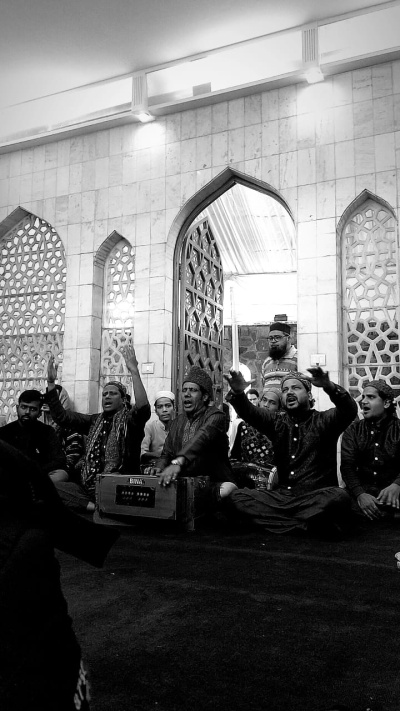The soundscape of a city is essentially ephemeral – it is an accumulation of sounds layered one over the other that constantly emerge and disappear. At the same time, there are musical traditions that seemingly do not belong to the modern soundscape of the city, but evoke a nostalgia for something in the past. A past that is lost and yet always evoked in song. This essay will consider the performance of Qawwali in South Asia and its reference to the lineage of Delhi. It will also look at the Sufi singer, poet, and scholar Amir Khusrau, whosesongs bear the trace of a lost time. In this piece, we will observe how in memorializing the past, Delhi emerges in Qawwali not as a location or an identity or a descriptive category, but always as a space of desire.
City and Memory
No city is ever generally beautiful. There is no abstract beauty of a city unless it is the immortal city of God. For us mortals, a city always presents something concrete and particular. It offers something singular, some particular beauty of circumstance or immediacy which is always invested in the present moment. The city of Delhi is no different. A vision of the bus stand in Chandni Chowk, a certain aroma in the back alleys of Jama Masjid, the sound of azan while waiting at the red light along Chirag Delhi – these are sensations of beauty which are neither general nor abstract. It doesn’t matter whether such sensations represent the past or the future. On the contrary, the pleasure we derive from them has the essential quality of their being in the present. Charles Baudelaire once wrote that «beauty is always and inevitably compounded of two elements, although the impression it conveys is one» (Beaudelaire 2006, 392). This double composition includes an eternal and an invariable element on the one hand, and a circumstantial element on the other hand. Whereas the former, being timeless and absolute, is difficult to determine, the latter always bears the mark of time and is relative to an epoch. Without the latter, he says, the former would be beyond our appreciation.
The sound of Qawwali which fills the bustling complex of Nizamuddin dargah in Delhi bears testimony to this double composition of beauty. Interwoven with the myriad soundscapes of the city, the beauty of these mystical tunes lies in the ambiguity that they express.
Qawwali is a musical genre specific to a Muslim Sufi tradition. It involves singing poetic verses or couplets (known as kalaam) in Persian, Hindi, and Urdu that evoke feelings of divine love, longing, and ecstasy. These songs are central to the ritual of Islamic mysticism in South Asia and are considered a powerful medium to attain union with God. Performed to date in ritual settings in Sufi shrines (mausoleum of a saint) as well as on professional stages, one can argue that Qawwali has an ambiguous relationship with time; it is sung in the present moment and yet does not belong to it.
The voice of the Qawwal does not belong to our epoch. It is not stamped by our time because it is a voice coming out of the past, marked by the memory of the 12 singers believed to be taught by Amir Khusrau himself, which still echoes among the Sufi shrines. These singers were known as Qawwal bachche, (the Qawwal offspring). It is claimed that for 700 years, descendants of this unbroken lineage have been practicing the Qawwali tradition and somewhere in their kalaam lingers the scent of the river Yamuna where the essence of Sufism was articulated by Amir Khusrau and Nizamuddin Auliya.
City and Voice
The verses in the voices of Qawwals distill the beauty of the past as if it were being performed in the present. More than being a mere representation of a tradition that is invested with grace and beauty, these kalaam evoke the very experience of the history of Qawwali. The sound of Qawwali is encountered in the present as something particular, concrete, and real among so many singular voices that a city space produces every day. Qawwali carries within itself the memory of another city. It becomes equally ephemeral, belonging to a bygone epoch and an elsewhere place. It is the unfolding of such a memory that activates our desire for a Delhi which is not there; like the great Mughal miniaturists, these voices paint images of time with sound.
In the end, one is reminded of the following couplet of Khwaja Nazir Nizami:
bani dehli dulhan doolha nizamuddin chishti hai
zamaana bhar baraati hai nizamuddin chishti ka
(Delhi has become a bride and the groom is Nizamuddin Chishti / the entire world takes part in the wedding procession of Nizamuddin Chishti)
It is as if the whole world gravitates towards the city while the bridal city seeks out its beloved – the voice which sings of Nizamuddin Chishti. The entire cosmos folds into the city that seeks something more pure than itself – something that lies elsewhere. And this continuous displacement, this desire for an elsewhere, is what the voice of the Qawwal evokes.



